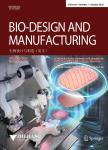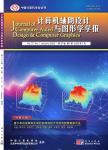
T=题名(书名、题名),A=作者(责任者),K=主题词,P=出版物名称,PU=出版社名称,O=机构(作者单位、学位授予单位、专利申请人),L=中图分类号,C=学科分类号,U=全部字段,Y=年(出版发行年、学位年度、标准发布年)
AND代表“并且”;OR代表“或者”;NOT代表“不包含”;(注意必须大写,运算符两边需空一格)
范例一:(K=图书馆学 OR K=情报学) AND A=范并思 AND Y=1982-2016
范例二:P=计算机应用与软件 AND (U=C++ OR U=Basic) NOT K=Visual AND Y=2011-2016

摘要:Modern medicine is increasingly interested in advanced sensors to detect and analyze biochemical *** sensors based on potentiometric methods are a promising platform for monitoring physiological ions in biological *** semi-implantable devices are mainly based on single-parameter *** semi-implantable electrodes for multiparameter sensing have more restrictions on the electrode size due to biocompatibility considerations,but reducing the electrode surface area could potentially limit electrode *** study developed a semi-implantable device system comprising a multiplexed microfilament electrode cluster(MMEC)and a printed circuit board for real-time monitoring of intra-tissue K^(+),Ca^(2+),and Na^(+)*** electrode surface area was less important for the potentiometric sensing mechanism,suggesting the feasibility of using a tiny fiber-like electrode for potentiometric *** MMEC device exhibited a broad linear response(K^(+):2–32 mmol/L;Ca^(2+):0.5–4 mmol/L;Na^(+):10–160 mmol/L),high sensitivity(about 20–45 mV/decade),temporal stability(>2weeks),and good selectivity(>80%)for the above *** vitro detection and in vivo subcutaneous and brain experiment results showed that the MMEC system exhibits good multi-ion monitoring performance in several complex *** work provides a platform for the continuous real-time monitoring of ion fluctuations in different situations and has implications for developing smart sensors to monitor human health.

摘要:传统的基于图像块划分的噪声强度估计方法通常先将图像划分为若干规则矩形图像块,并利用其中平滑的图像块进行噪声强度计算.然而当图像的结构信息比较丰富时,传统的方法往往会出现较大的偏差.为了解决该问题,提出一种基于自适应图像块划分的图像噪声强度估计方法.首先结合图像的空间邻域信息,将含噪图像划分为若干贴合图像局部边缘、纹理等结构信息的自适应图像块;然后根据所划分图像块的统计特性,通过散点图统计法选取出平滑的自适应图像块;最后利用平滑自适应图像块估计图像的噪声强度.实验结果表明,相比于已有的噪声估计方法,该方法在针对不同噪声强度、不同复杂程度的图像时更加准确和稳定.

摘要:单极势垒异质结构可以选择性地降低暗电流,但不影响光电流,是一种构建高性能光电探测器的有效策略.特别地,具有可调谐能带结构和自钝化表面的二维(2D)材料不仅能满足能带匹配要求,而且避免了界面缺陷和晶格失配,有助于设计单极势垒异质结构.这里,我们展示了一种混合维度WS_(2)/WSe_(2)/p-Si单极势垒异质结光电探测器.其中,2D WS_(2)充当光子吸收体,原子级厚度的WSe_(2)充当单极势垒,3D p-Si充当光生载流子收集器.插入的WSe_(2)不仅减轻了有害的衬底效应,而且形成了高导带势垒,可以过滤掉若干暗电流分量,同时不影响光电流.在隧穿效应和载流子倍增效应的驱动下,该WS_(2)/WSe_(2)/p-Si器件表现出高于10~5的高开/关比、2.39×10^(12)Jones的高探测度和8.47/7.98毫秒的快速上升/衰减时间.这些优点显著优于传统的WS_(2)/p-Si器件,为设计高性能的光电器件开辟了一个新方案.

摘要:将具有高催化活性的材料与等离激元金属纳米材料复合是制备局域表面等离激元共振增强电催化剂的常用策略.然而,这种复合方式不仅会降低等离激元材料的局域表面等离激元共振强度,同时会改变等离激元电磁场的逸散方式以及热电子在复合结构内部的传输途径,无法实现最佳的等离激元增强效果.在此,我们选择了简单的Ag@Pt双金属纳米立方体作为研究对象,深入探究了热电子在金属异质结构内部的激发和传输机制以及其在电化学析氢反应中的贡献.相应的实验和理论结果证实,Pt在Ag表面的复合会改变等离激元电磁场的逸散方式,促进激发产生更多热电子,同时热电子可以通过级联传输方式转移至复合结构表面,显著增强电催化反应.这项工作为等离激元金属异质结构催化剂的设计和应用提供了重要参考.

摘要:Anodic urea oxidation reaction(UOR)is an intriguing half reaction that can replace oxygen evolution reaction(OER)and work together with hydrogen evolution reaction(HER)toward simultaneous hydrogen fuel generation and urea-rich wastewater purification;however,it remains a challenge to achieve overall urea electrolysis with high ***,we report a multifunctional electrocatalyst termed as Rh/Ni V-LDH,through integration of nickel-vanadium layered double hydroxide(LDH)with rhodium single-atom catalyst(SAC),to achieve this *** electrocatalyst delivers high HER mass activity of0.262 A mg^(-1) and exceptionally high turnover frequency(TOF)of 2.125 s^(-1) at an overpotential of100 m ***,exceptional activity toward urea oxidation is addressed,which requires a potential of 1.33 V to yield 10 mA cm^(-2),endorsing the potential to surmount the sluggish *** splendid catalytic activity is enabled by the synergy of the Ni V-LDH support and the atomically dispersed Rh sites(located on the Ni-V hollow sites)as evidenced both experimentally and *** selfsupported Rh/Ni V-LDH catalyst serving as the anode and cathode for overall urea electrolysis(1 mol L^(-1) KOH with 0.33 mol L^(-1) urea as electrolyte)only requires a small voltage of 1.47 V to deliver 100 mA cm^(-2) with excellent *** work provides important insights into multifunctional SAC design from the perspective of support sites toward overall electrolysis applications.

摘要:Recent advances in non-radiative wireless power transfer(WPT)technique essentially relying on magnetic resonance and near-field coupling have successfully enabled a wide range of ***,WPT systems based on double resonators are severely limited to short-or mid-range distance,due to the deteriorating efficiency and power with long transfer *** systems based on multi-relay resonators can overcome this problem,which,however,suffer from sensitivity to perturbations and fabrication ***,we experimentally demonstrate a concept of topological wireless power transfer(TWPT),where energy is transferred efficiently via the near-field coupling between two topological edge states localized at the ends of a one-dimensional radiowave topological *** a TWPT system can be modelled as a parity-time-symmetric Su-Schrieffer-Heeger(SSH)chain with complex boundary ***,the coil configurations are judiciously designed,which significantly suppress the unwanted cross-couplings between nonadjacent coils that could break the chiral symmetry of the SSH *** tuning the inter-and intra-cell coupling strengths,we theoretically and experimentally demonstrate high energy transfer efficiency near the exceptional point of the topological edge states,even in the presence of *** combination of topological metamaterials,non-Hermitian physics,and WPT techniques could promise a variety of robust,efficient WPT applications over long distances in electronics,transportation,and industry.

摘要:柔性可穿戴的紫外线探测器在个体紫外线暴露监测、智能仿生眼和军事领域受到广泛关注.然而,传统不可拉伸的材料和器件结构设计限制了设备在可动态变形的人体皮肤和非平面表面上的精确监测应用和稳定附着.在本研究中,我们提出了基于氧化铜/碳-水凝胶-氧化锌/碳的新型应变隔离异质结构的本征可拉伸(拉伸应变或弯曲高达150%)紫外线探测器,该探测器具有高灵敏度(开/关比为2100%)、高稳定性(大于4000次循环),以及快速响应和恢复时间(分别为1.5和4 s).值得注意的是,该探测器通过水凝胶桥在氧化铜/碳和氧化锌/碳电极之间引入的p-n结能带结构,以及离子导电水凝胶中I^(-)/I_(3)^(-)的电化学反应机制,显著提高了其载流子效率和紫外线响应强度.本文通过集成传感器与所设计的电路板,进一步开发了一种无线紫外线报警系统,用于紫外线强度超标警报.此外,本文还设计了一种光电传感器阵列,并将其用作视网膜假体,以实现对环境紫外线强度的实时监测和成像.本文基于水凝胶基异质结构为开发可穿戴、可拉伸的光电紫外线传感器单元和成像阵列提供了一种新的可行方法.
地址:宁波市钱湖南路8号浙江万里学院(315100)
Tel:0574-88222222
招生:0574-88222065 88222066
Email:yzb@zwu.edu.cn

